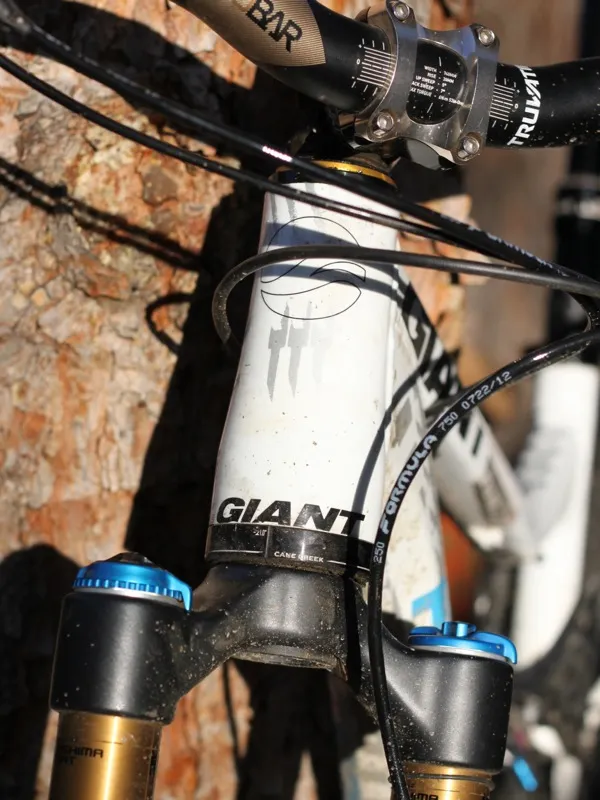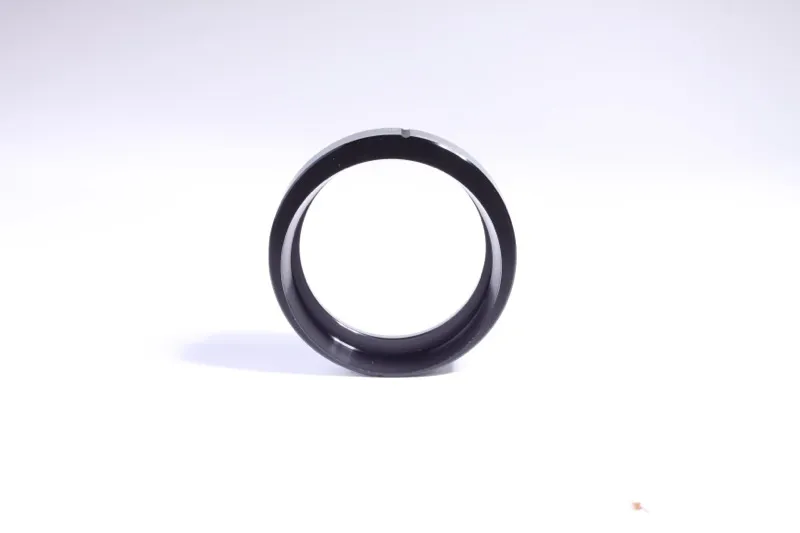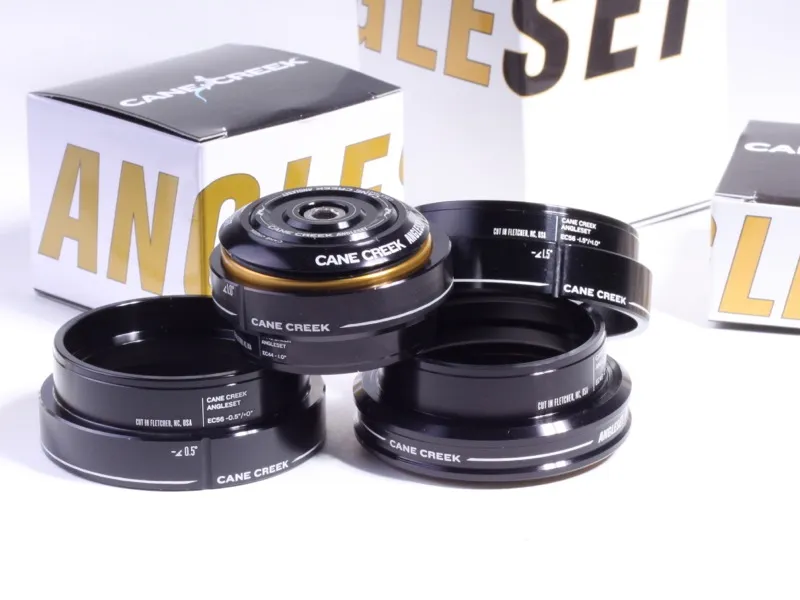Headsets are generally a 'set it and forget it' type of component – something you only think about when yours wears out or you're building up a new frame. But what if a headset could change the way your bike handles? That's just what Cane Creek’s AngleSet manages to do, making it a game changer.
The AngleSet fits most bikes with a 1.5in or tapered head tube and gives you impressive control over its head tube angle (and subsequently, wheelbase) through use of offset ball-joint style cups and bearing seats that self-align when preloaded.
The system gives up to 1.5° of adjustment either way (slacker or steeper) in 0.5° increments, for a total of six angle options, depending on head tube configuration. It comes down to this: the AngleSet gives you the rider, rather than a bike company's product manager, the last say when it comes to head angle.
We tested the AngleSet on two bikes – a 2011 Giant Reign and Ibis’s new Mojo SL-R. On the 6in-travel Reign we geeked out, first taking the frame from the stock 67.5° head angle to the steepest possible setting of 69° and then swinging almost all the way in the opposite direction to settle on 66.5°.
We’re not sure anyone would want to go steeper on the Reign, as its stock head angle seems to best complement its travel and purpose. However, when we swung slacker we became almost giddy with the change on some of our local area’s steep terrain with drops. The 66.5° setting was perfect for racing the Trestle All-Mountain Enduro; now if this darn Giant would accept a chain guide, we’d have an all-day-driving mini-downhill bike.

We slackened our test bikes by one degree
When we tested the 140mm-travel Mojo SL-R back at the start of the summer we were disappointed that its geometry wasn't as progressive as its design. In particular, we felt the 69° head angle was a bit steep for more aggressive riders and more testing terrain. The AngleSet came to the rescue, allowing us to step down to 67.5°, which helped the bike live up to its potential on technical trails.
But that’s not to say the AngleSet is only for slackening head angles. It's supplied as stock on many downhill bikes, where's it's used to steepen as well as slacken geometry to adjust for different courses and riding styles. For example, a racer may want to steepen the head angle for a more technical, slow-speed course and slacken it for a wide open, high-speed run.
Many of these bikes even come with pinch-bolt style head tubes to facilitate AngleSet cup changes without constantly pressing and pounding out the headset’s cups. Then there’s the story of a pro enduro racer we ride with who finds the bikes he's given just a tad too slack for his personal riding style. In this case, the AngleSet seems the perfect answer to keep both rider and sponsors happy.
What the AngleSet does is give riders the chance to geek out and be their own frame designer (in this small respect), which is darn fun and has the potential to make you fall in love with a bike that was just slightly off. Case in point, it allowed us to take a superlight carbon rig like the Mojo SL-R and really shred on it.
In the US the AngleSet's $150 pricetag (for a single set angle change; just under $200 for the six-degree set) looks like good value, too, given that it's of comparable quality to high-end headsets from the likes of Chris King. That price increases by about 20-percent for UK buyers, at £199, though, making alternative angle changing options like fixed headset cups and offset shock mounts look more attractive.

By changing the offset cups you can change your bike's head angle; depending on the head tube style the offset can come from the top or bottom cup
Cane creak?
Installation of the AngleSet is much more finicky than that of a standard threadless headset. The head tube needs to be faced and chased, and more care is needed to align the cups and set the gimbal bearing retainers. Adjustment, once installed, is similar to that of a standard model, but the AngleSet requires more preload on its bearings. Various configurations are available to fit different frames – if you're not sure which one you need, Cane Creek provide a handy configuration calculator.
When we first installed the AngleSet on the Giant Reign, here in the US, we experienced an initial bit of creaking, despite having prepped the head tube. We put this down to the fact that we'd installed it dry, as a liberal application of grease put an end to the noise. We've since used it for a further three months, swapping lower cups and forks periodically, without any further creaking.
“This is a common complaint,” Jim Morrison, Cane Creek’s headset engineer told BikeRadar. “Most people never have any problems, but those that do generally have a creaking issue and usually we can trace it back to [the headset] not being installed as we'd want it. If you take the Angleset and just assemble everything the way you would a standard headset, where you kind of drop the pieces together sequentially, things tend not to line up very well and you get creaking.”
Morrison suggests that if you have a problem with creaking, you should consult the Cane Creek website, which contains detailed instructions as well as two step-by-step videos, one of which you can watch below:
Unable to load media
On the Ibis, we had no such issue. However, Mountain Biking UK features editor Doddy experienced a similar problem with the AngleSet on his Trek Remedy 9.9. When first fitted, his headset was noise-free but after a day hitting bombholes with plenty of landings to flat it began to creak. A strip down and regrease ended the noise temporarily but hard riding in typically wet UK conditions brought it back. This was the case in both the -1° and -1.5° settings. We've heard reports of other AngleSets creaking, too – particularly those fitted to downhill and freeride bikes, where the head tube has to deal with the extra leverage of a longer fork.
“If it seems fine for a while and then it starts to creak, that’s usually evidence that something else is loosening up,” said Morrison. “That could be the stem slipping a hair, so always torque your stem to the recommended [spec] and make sure you have as much contact on the steerer tube as possible – we recommend running a spacer on top of the stem so you can have the whole length of the stem contact the steerer tube. We’ve had some issues with triple-clamps that have direct-mount stems, because they only have that one little pinch bolt right at the steerer tube, so there can be some slipping issues there, but that’s only with one or two manufacturers.”
Doddy found he could eliminate the creak by tightening the preload top cap, which is what Cane Creek recommend. “We find that people are a bit too tender with their preload,” said Morrison. “When you preload these things it’s pretty important to give it a firm preload, and the way we show it in the video is to use the small hand of a T-handle [Allen] wrench and torque it pretty hard by hand; you can kind of estimate that as 50in/lb.”
According to Morrison, it’s very hard to overload the bearings of a modern headset. “They’re load rated to thousands of pounds [and] you can generally pull the star nut out before you damage the bearings,” he said. “Don’t be too gentle on the preload because it ensures those gimbals are seating correctly and everything is all meshed up, because if they don’t seat then there’s the potential for noise.”

A look at a lower offset cup for tapered steerers

